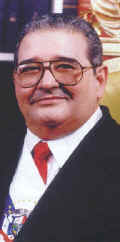MILITARY COUPS AND
COALITIONS
From 1903 until 1968, Panama was a
constitutional democracy dominated by a commercially oriented oligarchy.
During the 1950s, the Panamanian military [known as the National Guard
following conversion during that decade from the long-standing National
Police] began to challenge the
oligarchy's political hegemony. In October 1968, Dr. Arnulfo Arias Madrid,
twice elected president [1940 and1949] and twice ousted [1941 and 1951] by the
National Police, was ousted October 11, 1968, for the third
time as president by the National Guard after only 10 days in
office. A military junta government was established, and the commander of
the National Guard, Brigadier General Omar Torrijos [at that time a
lieutenant colonel], soon emerged as the principal
power in Panamanian political life. Torrijos' regime was harsh and
corrupt, but his charisma, populist domestic programs,
and nationalist (anti-U.S.) foreign policy appealed to the rural and urban
constituencies largely ignored by the oligarchy.
Torrijos' death in 1981 [in an airplane
crash in Panama] altered the tone
but not the direction of Panama's political evolution. Despite the 1983
constitutional amendments, which appeared to proscribe a political role
for the military, the Panama Defense Forces (PDF), as they were then known
[since the 1983 reorganization of the National Guard], continued to dominate Panamanian political life behind a facade of
civilian government. By this time, General Manuel Noriega was firmly in
control of both the PDF and the civilian government.
The United States froze economic and
military assistance to Panama in the summer of 1987 in response to the
domestic political crisis and an attack on the U.S. Embassy. General Noriega's February 1988 indictment in U.S. courts on drug-trafficking
charges sharpened tensions. In April 1988, President Reagan invoked the
International Emergency Economic Powers Act, freezing Panamanian
Government assets in all U.S. institutions [and prohibiting payments by American
agencies, firms, and individuals to the Noriega regime]. When national
elections were held in May 1989, Panamanians voted for the anti-Noriega
candidates [Guillermo Endara heading the opposition ticket] by a margin of over three-to-one. The Noriega regime promptly
annulled the election and embarked on a new round of repression. By the
fall of 1989, the regime was barely clinging to power, and the regime's
paranoia made daily existence unsafe for American citizens [including U.S. forces
and their dependents].
On December 20, 1989, President George H.W. Bush ordered
the U.S. military into Panama to protect U.S. lives and property, to
fulfill U.S. treaty responsibilities to operate and defend the Canal, to
assist the Panamanian people in restoring democracy, and to bring Noriega
to justice. The U.S. troops involved in Operation Just Cause achieved
their primary objectives quickly, and troop withdrawal began on December
27, 1989. Noriega eventually surrendered voluntarily to U.S. authorities.
He completed his sentence
for drug trafficking charges in September 2007. [His
sentence to a 30-year prison term in Miami for protecting
Colombian cocaine shipments through
Panama
in the 1980s was reduced for good behavior.] In
August 2007, a
U.S.
federal court in Miami
found Noriega extraditable to
France
to serve a sentence imposed
there after an in absentia conviction for money laundering. Noriega
remains in custody pending the outcome of his legal challenges to the
certificate of extraditability issued August 2007.
REBUILDING DEMOCRACY
Panama
's
Electoral Tribunal moved quickly to rebuild the civilian
constitutional government, reinstated
the results of the May 1989 election on
December
27, 1989
,
and confirmed the victory of President Guillermo Endara and Vice
Presidents Guillermo Ford and Ricardo Arias Calderon.



